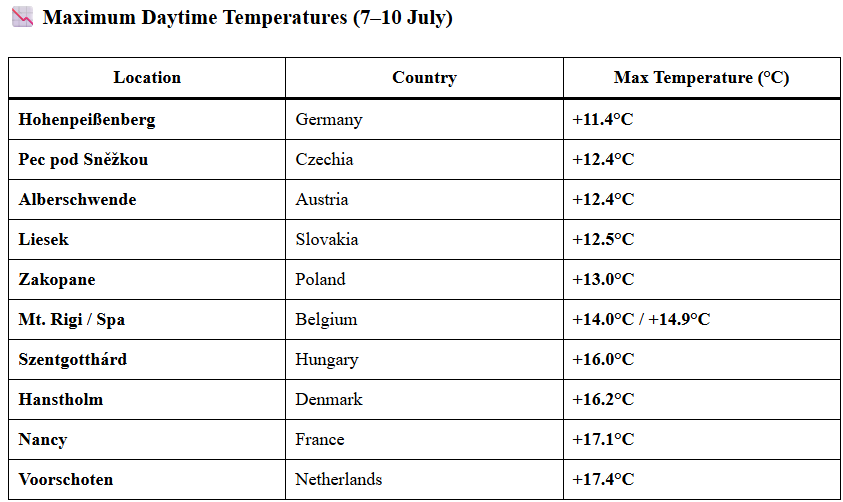
A mid-summer cold outbreak stuns Central Europe with autumn-like highs
Between 7 and 10 July 2025, an anomalously cold upper-level low became quasi-stationary over Central Europe, leading to widespread record-breaking low maximum temperatures. Instead of the expected summer warmth, regions from the Alps to the North Sea coast faced cloudy skies, persistent drizzle, and daytime highs more typical of October than high summer.
📉 Maximum Daytime Temperatures (7–10 July)
| Location | Country | Max Temperature (°C) |
|---|---|---|
| Hohenpeißenberg | Germany | +11.4°C |
| Pec pod Sněžkou | Czechia | +12.4°C |
| Alberschwende | Austria | +12.4°C |
| Liesek | Slovakia | +12.5°C |
| Zakopane | Poland | +13.0°C |
| Mt. Rigi / Spa | Belgium | +14.0°C / +14.9°C |
| Szentgotthárd | Hungary | +16.0°C |
| Hanstholm | Denmark | +16.2°C |
| Nancy | France | +17.1°C |
| Voorschoten | Netherlands | +17.4°C |
These values represent daily highs, not nighttime lows — confirming the strength of the thermal suppression caused by dense stratiform cloud decks and limited solar insolation.
🌀 Synoptic Setup and Meteorological Analysis
The core driver of this cold spell was a cut-off low-pressure system at 500 hPa, embedded in a retrograde flow pattern. This system:
- Imported cold maritime polar air from the Norwegian Sea
- Was blocked by an amplified Azores-British Isles ridge, stalling eastward movement
- Generated persistent cloud cover, orographic rain, and diurnal temperature flattening
Such omega-block configurations are relatively rare in mid-July and were reinforced by a negative NAO phase, which weakened the zonal jet stream and promoted meridional flow.
In highland and valley locations (e.g. Zakopane, Pec pod Sněžkou, Liesek), thermal inversions and fog entrapment further depressed daytime highs, while low-level wind convergence supported continued advection of cool air.
🌫️ Climatic Significance & Pattern Deviations
This event contradicts the general warming trend observed in European summers, offering a stark reminder of natural variability and regional cold extremes even in a warming climate. Similar cold outbreaks have occurred — notably in July 1984 and July 2000 — but this episode featured exceptionally low maxima across a wide swath of Central Europe.
The juxtaposition of this cold core with intense heat over Southern Europe (Spain, Italy, Balkans) underlines a rising pattern: intra-continental thermal bifurcation, likely intensified by amplified Rossby wave activity.


























